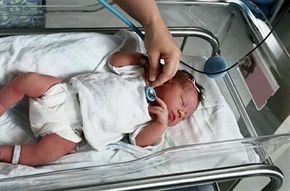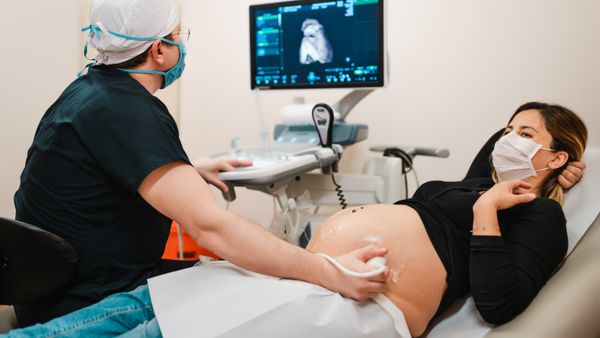All parents hope and expect to experience a normal pregnancy and take home a healthy child. Although the majority of pregnancies and deliveries are uneventful, some involve complications that range from minor to life threatening -- for the mother, for the baby, or for both. Complications of pregnancy may develop gradually or suddenly and without warning. One objective of prenatal care is the prompt diagnosis and treatment of these complications before they worsen. In this article, we describe the most common complications of pregnancy, their causes and symptoms, and their treatment over the following sections:
- Pregnancy Complications in Older Mothers In recent years there has been a trend toward having babies later in life. But more pronounced chronic diseases in the mother, among other conditions, can have an adverse affect on the developing fetus. Fortunately, prenatal care is similar for women of all ages, but this page will tell you some symptoms that women older than 35 should watch out for.
- Pregnancy Complications in Teenage Mothers Most teenagers are not ready -- physically or emotionally -- to have children. As a result, birth weight is typically lower and babies of teens are more susceptible to certain illnesses. It will take an effort on the part of the teenage mom to ensure the health of her baby. This page tells you how to do it.
- Preterm Birth About 11 to 12 percent of deliveries in the United States are classified as premature, which is a birth that occurs between the 20th and 36th weeks of pregnancy. This is a dangerous condition for the baby, which might not be able to survive outside of the womb. But modern medicine has helped many premature babies survive and grow up normally. On this page you'll learn why you must go to the hospital immediately if you suspect you're going into labor prematurely.
- Postterm Birth If a baby still has not arrived two weeks past its due date, it may be in danger of malnutrition or even pneumonia. There is no danger to the mother, but a doctor may choose to induce labor for the baby's health. This page will tell you what happens in that case.
- Ectopic Pregnancy An ectopic pregnancy is one in which the fertilized egg settles outside the uterus. This can be a very painful, and dangerous, condition for the mother, and if an ectopic pregnancy is detected the mother will be hospitalized immediately. This page will show you how to tell if you have an ectopic pregnancy, and what your doctor will do.
- Stillbirths Stillbirth, the death of a baby before it is born, is becoming rare thanks to improved prenatal care. However, this tragic outcome of a pregnancy can happen, usually when the flow of nutrition from the placenta is cut off. This page will tell you how a doctor will detect a stillbirth.
- Miscarriages About 15 percent of known births end in miscarriage, when a baby is born too early in the pregnancy to be viable. Although many doctors prescribe bed rest if they suspect a miscarriage is possible, most believe there is no way to prevent one. This page will tell you the different types of miscarriage and the factors that contribute to them.
- Multiple Births Twins can double the joy of being a new mother, but they can also present health risks. The most common risk of a multiple birth is premature labor, and a breech birth -- with the baby coming out feet first rather than head first -- is common as well. Although the reasons for multiple births are not fully understood, this page will tell you what do to if you're carrying more than one fetus.
- Placenta Complications A woman shouldn't experience any vaginal bleeding during pregnancy. If you do, it may be a sign of placenta previa or placental abruption. These are two conditions in which the placenta does not behave normally, and they almost always lead to a cesarean section. Find out more about these abnormalities on this page.
- Cesarean Section About 30 percent of U.S. babies are born via cesarean section, in which a baby is removed through an incision in the mother's abdomen. There are many reasons why this procedure would be necessary, but it's always for the health of the baby or the mother and it's extremely safe. This page goes over the reasons and explains the two types of cesarean section.
- Birth Defects Birth defects can affect the head, face, eyes, mouth, hands, feet, and internal organs. Some minor birth defects can be corrected and leave no trace, but others are more severe and stay with the baby for life. This page details numerous birth defects, from cleft palate and clubfoot to spina bifida and Down syndrome.
- Rh Incompatibility If a mother and fetus don't have compatible blood, there can be severe complications for the fetus. Furthermore, any fetus the mother carries in the future is at risk, too, unless a doctor takes the proper steps to sensitize the mother. Find out what Rh is, how it affects your pregnancy, and what your doctor will do about it on this page.
- Deseases During Pregnancy The baby isn't the only one who's at risk. Pregnancy can cause health issues for the mother too, from simple swelling of the hands and feet to increased risk of heart and kidney disease. And existing conditions in the mother, such as diabetes, can endanger a fetus. Most mothers are healthy throughout their pregnancy, but this page will tell you how to stay that way.
- Abnormalities of Labor Labor is a complicated process that can become difficult in several ways. If the baby and the umbilical cord are not positioned correctly, for example, the doctor may have to perform a cesarean section. Here you'll see what your doctor will be looking for and what he or she will do to correct anything that goes wrong.
This information is solely for informational purposes. IT IS NOT INTENDED TO PROVIDE MEDICAL ADVICE. Neither the Editors of Consumer Guide (R), Publications International, Ltd., the author nor publisher take responsibility for any possible consequences from any treatment, procedure, exercise, dietary modification, action or application of medication which results from reading or following the information contained in this information. The publication of this information does not constitute the practice of medicine, and this information does not replace the advice of your physician or other health care provider. Before undertaking any course of treatment, the reader must seek the advice of their physician or other health care provider.
Advertisement


